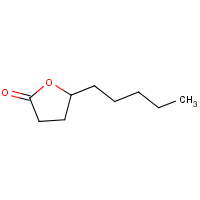gamma-Nonalactone
Agent Name
gamma-Nonalactone
Alternative Name
Dihydro-5-pentyl-2(3H)-furanone
CAS Number
104-61-0
Formula
C9-H16-O2
Major Category
Other Classes

Synonyms
Dihydro-5-pentyl-2(3H)-furanone; 1,4-Nonalolide; 1,4-Nonyl lactone; 2(3H)-Furanone, dihydro-5-pentyl-; 4-Amyl-4-hydroxybutyric acid lactone; 4-Hydroxynonanoic acid, gamma-lactone; 4-Nonalactone; 4-Nonanolide; 4-Pentyl-butanolide; Aldehyde C-18; Coconut aldehyde; Nonan-1,4-olide; Nonanoic acid, 4-hydroxy-, gamma-lactone; Prunolide; gamma-Amyl-gamma-butyrolactone; gamma-n-Amylbutyrolactone; gamma-Nonanolactone; gamma-Nonanolide; gamma-Nonylactone; gamma-Nonyllactone; gamma-Pelargolactone; gamma-Pentyl-gamma-butyrolactone; [ChemIDplus]
Category
Lactones
Description
Colorless to pale straw-yellow liquid with an odor of coconut; [HSDB]
Sources/Uses
Reportedly found in peaches, apricots, roasted barley, rum, and tomatoes; Used as flavoring and fragrance ingredient; [HSDB] Used in the US as insecticide, insect and mammal repellent, and mosquito larvicide; [Reference #1]
Comments
A mutagen and severe skin irritant; Causes somnolence and abnormal liver and kidney function tests in high-dose animal studies; [RTECS] Safe to use as a flavoring agent in food; ADI = 0-1.25 mg/kg/ bw; [JECFA] Absorbed quickly by oral dosing in rats, and excreted mainly in urine (~64%) and to lesser extent feces (~32%); Low toxicity in gavage studies with cats and rats; Not irritating to skin of rabbits or humans; Not sensitizing to skin of guinea pigs or humans; An eye irritant in rats; Increased liver weights (no accompanying histopathological changes) observed in 90 day gavage study with rats; No significant adverse effects in two generation study with rats; [European Commission] Caused no skin irritation or sensitization in 25 human volunteers (10% in petrolatum); No significant adverse effects observed in feeding studies with rats (studies ranging from two weeks to two years); [HSDB] Low acute oral, dermal, and inhalation toxicity; Not irritating to skin or eyes and not sensitizing to skin; [Reference #1] See "Butyrolactone."
Reference Link #1
Biomedical References
Exposure Assessment
Adverse Effects
Neurotoxin
Acute solvent syndrome
Hepatotoxin
Hepatoxic (a) from occupational exposure (secondary effect) or (b) in animal studies or in humans after ingestion
Diseases, Processes, and Activities Linked to This Agent
Diseases
Occupational diseases associated with exposure to this agent: